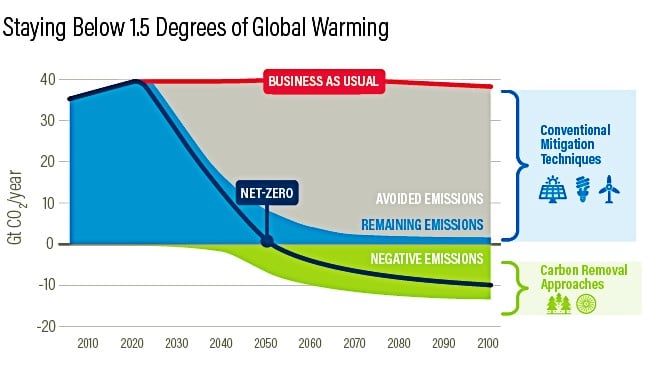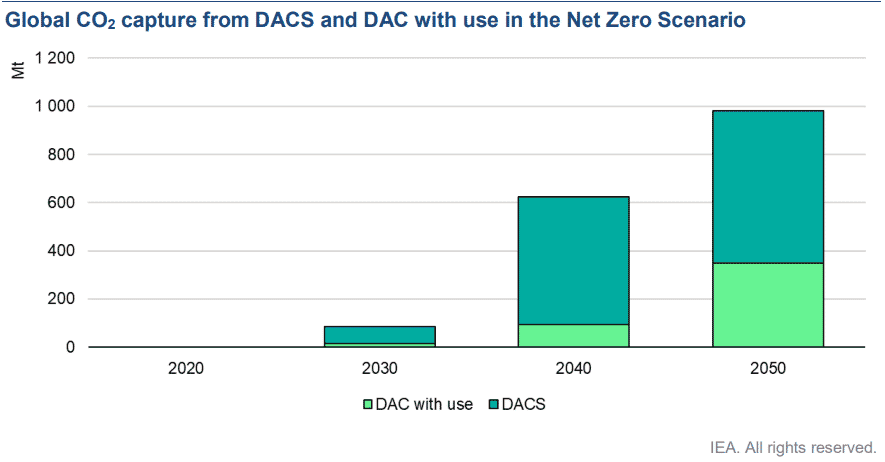The market for carbon sequestration has enjoyed an exponential growth in recent years, attracting vast interest from investors and governments. The main reason is that carbon sequestration technologies are not just beneficial to honoring our climate commitments, but crucial.
The Paris Agreement signed in 2016 set out an ambitious goal: to ensure that an increase in the average global temperature stays under 2C, ideally 1.5C. This means that we can only afford to emit 400 gigatons of carbon emissions to stay under this limit.
What countries around the world have discovered is that this goal is not achievable by implementing renewables alone. The pace of developing renewable technologies cannot keep up with the rate at which the world is emitting carbon dioxide.
Hence, carbon sequestration and removal needs to scale up significantly to remove existing emissions and halting continuing carbon emissions.
Scientists estimated that the world has to remove up to 10 GtCO2 annually from the atmosphere by 2050 to decarbonize. That removal capacity should double per year by 2100 as shown in the chart below.

The current carbon removal and sequestration market explores a broad range of technologies. This includes capturing carbon dioxide using large fans, changing the pH of the ocean to store more CO2 to recycling carbon emissions in cement production.
Here are the top 5 carbon sequestration companies to watch for in 2024:
Aker Carbon Capture
Location: Norway, Northern Europe
Founded: 2020
A subsidiary of Aker Solutions, Aker Carbon Capture is one of the largest and most established of the carbon sequestration companies.
It is one of the few publicly traded companies in the sector. It was listed in the Oslo Stock Exchange in 2020, and has a current market cap value of $750.65 million.
The company uses their proprietary carbon capture solution to capture CO2 from waste flue gases from a variety of industries such as oil refineries and cement plants. Its key offerings include modular solutions that are easy to transport and install. They also offer offshore and integrated solutions.
Though it was only established in 2020, it uses technology that has been developed by Aker for over 10 years. One of their current key projects is the Brevik cement plant which has a CO2 sequestration capacity of 400,000 tons per annum.
Climeworks
Location: Switzerland
Founded: 2009
Climeworks is another established carbon sequestration company that uses direct air capture (DAC). The company recently raised $650 million in funding, the largest ever for a startup in the carbon removal sector.
It uses its modular CO2 collectors, where large industrial fans draw in CO2-containing air into the plant, and a CO2-selective filter separates the carbon dioxide.
So far, Climeworks has sold the collected CO2 to greenhouses and carbonated beverage companies. Recently, it has taken a step further and partnered with another carbon sequestration company called Carbfix to permanently store this CO2 instead of reselling it.
It launched its carbon capture and storage facility called Orca in 2021, in partnership with Carbfix. The facility has the capacity to capture around 4,000 tons of carbon per annum. To date, it is the only direct air capture plant that permanently sequesters the CO2 instead of recycling it.
Carbon Clean
Location: London, UK
Founded: 2009
To date, Carbon Clean has used its proprietary carbon capture process technology to sequester 588 metric tons of CO2. It has raised a total of $212 million in funding.
One of its key partnerships is the industrial-scale carbon capture and utilization plant in Chennai, India which has an annual capacity to capture 60,000 tons of CO2.
In 2021, the company launched its new solution, CycloneCC, which can achieve over 90% carbon capture rates. The company also prides itself on being cost-effective, as they claim they can capture CO2 for less than $30 per metric ton.
Carbfix
Location: Reykjavik, Iceland
Founded: 2006
Carbfix is a leading player in the carbon sequestration sector due to its novel carbon capture and storage technology. Carbfix’s technology aims to permanently store captured CO2 underground in rocks. Unlike other solutions in the sector, where the CO2 needs recycling, Carbfix offers a more permanent carbon sequestration solution.
Its key projects and partnerships with Climeworks are the aforementioned Orca plant and the EU-funded Arctic Fox pilot plant. To date, the company has raised $117 million in funding.
Carbon Engineering
Location: Vancouver, Canada
Founded: 2009
Carbon Engineering is another big name in the sector that has raised a total funding worth $110 million. Its unique liquid DAC process that uses potassium hydroxide solution to capture CO2 has earned trusts and investments from Bill Gates, Chevron, Occidental, Airbus, Air Canada, and more.
Carbon Engineering licensed its DAC technology to 1PointFive, aiming to build a megaton scale plant in the Permian Basin, U.S., capable of capturing 1 million tons of CO2/year in 2024.
What makes it stand out from other carbon sequestration companies is that apart from its DAC plants, it also has air-to-fuels plants that can deliver global-scale quantities of clean fuels using captured CO2. These facilities will be operational in 2026.
Carbon Sequestration Companies for Net Zero
Carbon capture or DAC plays an important role in meeting net zero emissions goals. In fact, the world needs the services of the carbon sequestration companies to bring the global energy system to net zero by 2050. Here’s the potential of these technologies in reaching net zero.
Estimations by the International Energy Agency showed that DAC can capture over 85 million tons of CO2 in 2030 and 980 million in 2050. But that needs a lot of work to do from those top carbon sequestration companies to help scale up the sector.
The good news is that the mega trend today indicates high regard for more investments in the space both from the public and private sectors. And through these carbon capture and removal technologies, businesses can meet and perhaps exceed their net zero targets.


